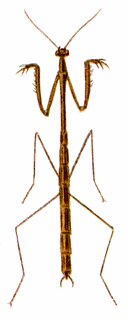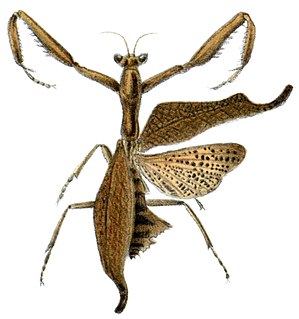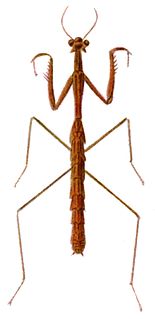
Iris oratoria, known by the common name Mediterranean mantis or iris mantis, is a widespread species of praying mantis native to Europe. It is found as an introduced species in the Middle East, Western Asia and the United States. Iris oratoria invaded southern California in the 1930s and seems to be spreading.

Choeradodis is a genus of praying mantises with common names such as shield mantis, hood mantis, and leaf mantis because of their extended, leaf-like thoraces. The distinguishing characteristic of Choreododis from which it takes its common names is a laterally expanded thorax. This adaptation for the purpose of camouflage, as well as a rounded wing case and a habit of staying relatively flattened, aid its leaf mimicry.

Phyllocrania paradoxa, common name ghost mantis, is a small species of mantis from Africa remarkable for its leaf-like body. It is one of the three species in the genus Phyllocrania. It is known for its distinct and exclusive camouflaged appearance of a dry weathered leaf.

Brunneria borealis, common name Brunner's mantis, Brunner's stick mantis, or northern grass mantis, is a species of praying mantis native to the southern United States. It is the only mantis species known to reproduce solely through parthenogenesis; there are no males.

Thesprotia graminis, common name American grass mantis or grass-like mantis, is a species of praying mantis native to the Southern United States. It is found in Florida and Georgia. This species can reproduce parthenogenetically or through sexual reproduction. T. graminis is similar in appearance to Brunneria borealis.
Deroplatys desiccata, known by the common name giant dead leaf mantis, is a praying mantis from Southeast Asia. This is the type species of genus Deroplatys.

Acanthops falcataria, common name South American dead leaf mantis, is a species of praying mantis in the family Acanthopidae. It is not to be confused with Acanthops falcata, a different species in the same genus that is often referred to with the same common name.

Stick mantis and twig mantis are common names applied to numerous species of mantis that mimic sticks or twigs as camouflage. Often the name serves to identify entire genera such as is the case with:

Stagmomantis limbata, common name bordered mantis, bosque mantis, Arizona mantis, or New Mexico praying mantis is a species of praying mantis native to North America, most prevalent in the Southwestern United States. This beneficial insect is green or beige in color and grows up to around 3 inches long.
Grass mantis is a common name mostly given to various species of praying mantis that mimic grass or other slender vegetation. Species to which this name has been applied include but are not limited to:

Sphodromantis is a large genus of praying mantises concentrated in Africa, sometimes considered a synonym of the genus Hierodula: from the same tribe, Paramantini. Outside their range especially, many share the common name African Mantis.
Pseudovates peruviana, common name Peruvian stick mantis, is a medium-sized species of praying mantis native to South America and more specifically to Peru.
Ground mantis is a common name given to various species of praying mantis believed to hunt on or near ground level rather than high amid foliage.

Acanthops is a genus of mantises in the family Acanthopidae, containing 20 species that can be found in Central and South America.
Acanthops royi is a species of praying mantis in the family Acanthopidae and is one of many mantis from various genera that resembles a dead leaf.
Acanthops centralis is a species of praying mantis in the family Acanthopidae and is one of many mantis from various genera that resembles a dead leaf.

Miomantis paykullii is a species of praying mantis in the genus Miomantis in the order Mantodea.
Acanthops falcata, common name South American dead leaf mantis or boxer mantis, is a species of praying mantis in the subfamily Acanthopinae of the family Acanthopidae and is one of many praying mantises from various genera that resembles a dead leaf.

Mantises are an order (Mantodea) of insects that contains over 2,400 species in about 430 genera in 30 families. The largest family is the Mantidae ("mantids"). Mantises are distributed worldwide in temperate and tropical habitats. They have triangular heads with bulging eyes supported on flexible necks. Their elongated bodies may or may not have wings, but all Mantodea have forelegs that are greatly enlarged and adapted for catching and gripping prey; their upright posture, while remaining stationary with forearms folded, has led to the common name praying mantis.












